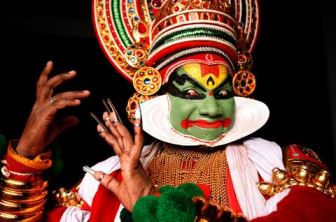Kathakali Dance

One of the most easily recognisable dance forms of India, Kathakali, is Kerala’s unique gift to the world of performing arts. This centuries-old dance form has been well preserved by generations of artists who have meticulously recreated it, keeping all the little details intact.
Kathakali is said to have originated in the seventh century and spread with the support of the King of Kottarakara, who was one of the earliest appreciators of this art form. The literal meaning of the word Kathakali is story play or enactment of a story. As the name suggests, the dance uses music, costumes, facial expressions and movements to enact scenes from mythological stories such as the Ramayana and the Mahabharata.
The elaborate depiction of characters in the dance takes hours of preparation. The most characteristic features of Kathakali Dance are its grand costumes and bright make up. The different colours seen on the faces of the artists have different meanings such as green for nobility and black for evil. These paints are naturally prepared by mixing stone powder pigments to coconut oil. The entire make up procedure happens in three stages where both the artist and his make -up artist have a significant role.
The dance usually begins in the evening and goes on till night. It gives equal importance to facial expressions and body movements. A lamp is usually placed on the stage which used to be the sole source of light for the performance in the early days. Musicians stand behind the dancers in a semi -circle with instruments such as drums, flute, gong and harmonium. Though the costumes appear feminine, Kathakali is performed only by men who wear different makeup and outfits to depict both male and female characters. Females perform a dance called Kummi which is like Kathakali but gentler in its rendition.
The underlying message, however, of all Kathakali recitals is the universal truth of good prevailing over evil in any form.





